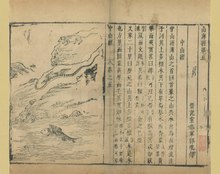The Chinese classics or canonical texts are the works of Chinese literature authored prior to the establishment of the imperial Qin dynasty in 221 BC. Prominent examples include the Four Books and Five Classics in the Neo-Confucian tradition, themselves an abridgment of the Thirteen Classics. The Chinese classics used a form of written Chinese consciously imitated by later authors, now known as Classical Chinese. A common Chinese word for "classic" literally means 'warp thread', in reference to the techniques by which works of this period were bound into volumes.
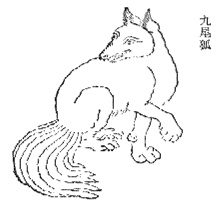
Huli jing are Chinese mythological creatures usually capable of shapeshifting, who may either be benevolent or malevolent spirits. In Chinese mythology and folklore, the fox spirit takes variant forms with different meanings, powers, characteristics, and shapes, including huxian, hushen, husheng, huwang, huyao, huzu, and jiuweihu.

A nian beast is a beast in Chinese mythology. According to Chinese mythology, the nian lives under the sea or in the mountains. The Chinese character nian more usually means "year" or "new year". The earliest written sources that refer to the nian as a creature date to the early 20th century. As a result, it is unclear whether the nian creature is an authentic part of traditional folk mythology, or a part of a local oral tradition that was recorded in the early 20th century. Nian is one of the key characters in the Chinese New Year. Scholars cite it as the reason behind several practices during the celebration, such as wearing red clothing and creating noise from drums and fireworks.
Merfolks, Mercreatures, Mermen or Merpeople are legendary water-dwelling human-like beings. They are attested in folklore and mythology throughout the ages in various parts of the world.
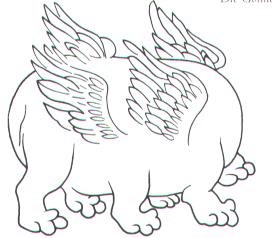
Hundun is both a "legendary faceless being" in Chinese mythology and the "primordial and central chaos" in Chinese cosmogony, comparable with the world egg.

The burning of books and burying of scholars was the purported burning of texts in 213 BCE and live burial of 460 Confucian scholars in 212 BCE ordered by Chinese emperor Qin Shi Huang. The events were alleged to have destroyed philosophical treatises of the Hundred Schools of Thought, with the goal of strengthening the official Qin governing philosophy of Legalism.
The term Nine Provinces or Nine Regions, is used in ancient Chinese histories to refer to territorial divisions or islands during the Xia and Shang dynasties and has now come to symbolically represent China. "Province" is the word used to translate zhou (州) – since before the Tang dynasty, it was the largest Chinese territorial division. Although the current definition of the Nine Provinces can be dated to the Spring and Autumn and Warring States periods, it was not until the Eastern Han dynasty that the Nine Provinces were treated as actual administrative regions.

The nine-tailed fox is a mythical fox entity originating from Chinese mythology.
Bashe was a python-like Chinese mythological giant snake that ate elephants.
Li Daoyuan was a Chinese geographer, writer, and politician during the Northern Wei Dynasty. He is known as the author of the Commentary on the Water Classic (Shuijingzhu), a monumental work on China's geography in ancient times.
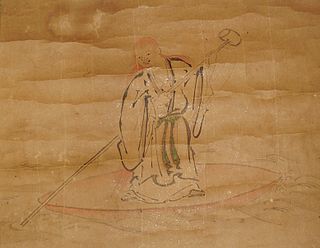
A shōjō is the Japanese reading of Chinese xing-xing (猩猩) or its older form sheng sheng, which is a mythical primate, though it has been tentatively identified with an orangutan species.

Hòutǔ or Hòutǔshén, also Hòutǔ Niángniáng, otherwise called Dimǔ or Dimǔ Niángniáng, is the deity of all land and earth in Chinese religion and mythology. Houtu is the overlord of all the Tudigongs, Sheji, Shan Shen, City Gods, and landlord gods world wide.
Jade Mountain is a mythological mountain in Chinese mythology and the residence of The Queen Mother of the West.
In Chinese mythology, the xiao is the name of several creatures, including the xiao "a long-armed ape" or "a four-winged bird" and shanxiao "mischievous, one-legged mountain spirit". Furthermore, some Western sources misspell and misconstrue the older romanization hsiao as "hsigo" [sic] "a flying monkey".

The Qiantang River, formerly known as the Hangchow River or Tsientang River, is a river in East China. An important commercial artery, it runs for 459 kilometers (285 mi) through Zhejiang, passing through the provincial capital Hangzhou before flowing into the East China Sea via Hangzhou Bay south of Shanghai. Its original name, the "Zhe River" or "Zhe Jiang", is the origin of the name of Zhejiang province. The river is also known, along with Hangzhou Bay, for having what is called by locals as the "Silver Dragon", the world's largest tidal bore, a phenomenon where the leading edge of the incoming tide forms a wave that can rise to a height of 9 meters (30 ft) and travels up the river or narrow bay at top speeds of 40 km/h against the direction of the river or bay's current, and can be seen from miles away.
The Flood Mythology of China, or Great Flood of China is a deluge theme which happened in China. Derk Bodde (1961) stated that "from all mythological themes in ancient Chinese, the earliest and so far most pervasive is about flood." The mythology also has shared characteristics with other Great Floods all over the world, although it also has unique characteristics or different focuses. Lu Yilu (2002) groups all versions of great flood into three themes: "the heroes controls the flood; "brother-sister marriage to repopulating the world"; and "the flood which is drowning the whole city along with its citizens".
Twelve Views of Bayu are popular scenic views in and around the city of Chongqing, China. Ba and Yu are old names of Chongqing in Imperial times. Influenced by Eight Views of Xiaoxiang in Hunan Province, people in Chongqing listed their own most beloved views during the reign of the Tianshun Emperor of the Ming dynasty. Scenic views in the list changed throughout the history. Some scenic views appeared in earlier lists no longer exist in modern days due to the change of physical geography, landscapes and land-uses.
Langgan is the ancient Chinese name of a gemstone which remains an enigma in the history of mineralogy; it has been identified, variously, as blue-green malachite, blue coral, white coral, whitish chalcedony, red spinel, and red jade. It is also the name of a mythological langgan tree of immortality found in the western paradise of Kunlun Mountain, and the name of the classic waidan alchemical elixir of immortality langgan huadan 琅玕華丹 "Elixir Efflorescence of Langgan".
Xue Tao is a Chinese writer of children's books.
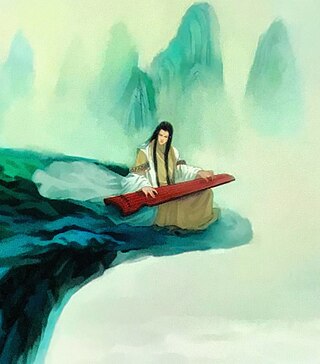
Taizi Changqin or Prince Changqin is a deity in Chinese religion. He is the only son of the fire god Zhurong and was the first musician in the Three Realms. He appears in the Classic of Mountains and Seas and Commentary of Zuo.
